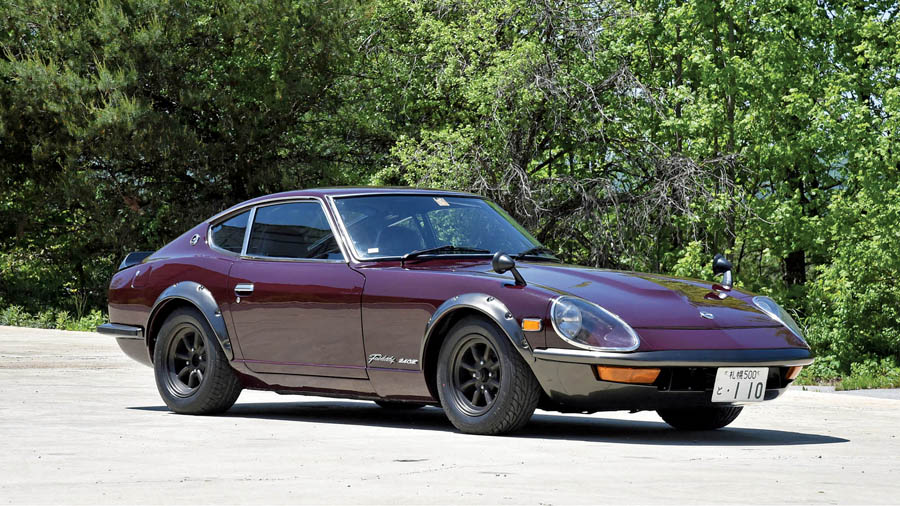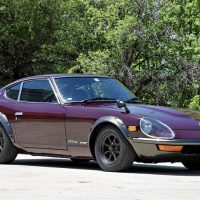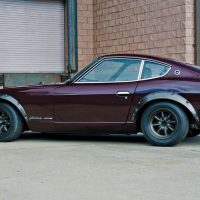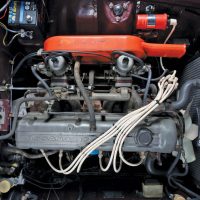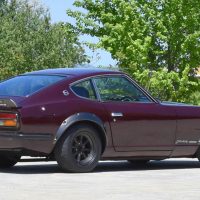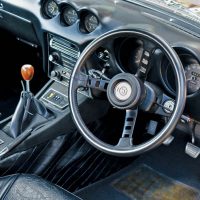- Genuine Fairlady ZG, first registered in September 1972 in the Shinagawa District of Tokyo
- Bought in Japan in 2013; imported and titled by one of the USA’s leading Japanese Domestic Market car collectors
- Matching numbers
- Original colors
- Running condition
- Includes service history, books, manuals and toolkit
SCM Analysis
Detailing
| Vehicle: | 1972 Nissan Fairlady ZG |
| Years Produced: | 1971–72 |
| Number Produced: | Group 4 rules required 500 homologation cars, but no official records exist |
| Original List Price: | ¥1,500,000 ($4,762) |
| SCM Valuation: | Median to date, $60,500 (this car is the only Fairlady ZG sold at auction); high sale: $60,500 (this car) |
| Tune Up Cost: | $200 |
| Distributor Caps: | $14 |
| Chassis Number Location: | Right side firewall |
| Engine Number Location: | Right side inner fender |
| Club Info: | Z Car Club Association |
| Website: | http://www.zcca.org |
| Alternatives: | 1967 Jaguar XKE Series I 4.2 coupe, 1968 Ford Mustang GT fastback, 1972 Alfa Romeo Montreal |
| Investment Grade: | B |
This car, Lot 143, sold for $60,500, including buyer’s premium, at The Finest Automobile Auctions sale in Hershey, PA, on June 11, 2016.
The phenomenon of depreciated used cars suddenly becoming coveted classics always seems to catch the collecting world off guard. The Next Gen profile in each issue of Sports Car Market is our attempt to track the pulse of this leading edge of collectibility.
For Japanese Domestic Market cars, however, the discussion is not just a matter of finding fresh appreciation for the familiar and dismissed. It’s about the thrill of obscure, historically significant automobiles entering the Western market — and perhaps even our Western awareness — for the first time.
The most recent case in point is our subject car, the Nissan Fairlady ZG.
That time the Z went aero
SCM has twice recounted the legacy of Nissan’s fabled S20 inline 6, the fire-breathing race motor that powered the Skyline GT-R (Next Gen Profile, November 2015, p. 102) and Fairlady Z 432 (June 2015, p. 76). The 432 remains the ultimate production Z, but Nissan could not sell the cars for a profit and ceased production in 1971.
In pursuit of the next competitive advantage, engineers went aero with the Z, adding a lengthened fiberglass front end, headlight covers, a rear wing and wider, riveted-on fenders. Group 4 rules required the features to be homologated with 500 production cars, and the Fairlady ZG was born. The car is seven inches longer than the standard Z. Power came from the same 2.4-liter, 150-hp L24 engine as the 240Z.
A ZG won at the 1972 Fuji Grand Champion Series, and the car became an icon in its native Japan — the only place where the production ZG was sold. While American Z-lovers could not buy a ZG, the distinctive “G nose” was available separately from Datsun dealerships. U.S. enthusiasts today refer to their ZG clones as “240ZGs,” and the cars are highly desirable.
First stab at a never-sold-here JDM classic
ZGs in Japan trade in the ¥11m–¥13m (about $100k–$125k) range, as the buyer of this car was well aware, and this was the model’s first appearance at a U.S. auction. When bidding stopped, the buyer knew he had scored a deal.
In a telephone interview, he said that while he wouldn’t have paid a Japanese-market price, he was prepared to bid a little higher. His wife also liked the car, which always helps. He speculates that he outbid one other buyer in the room and perhaps one on the phone.
The buyer, who was familiar with the car on offer, described it as not a show car, but a very nice driver. It was fitted with a Datsun racing steering wheel and rear brace, and the paint had gone from its original maroon to silver and back again. The most notable deviation from stock was the thick Watanabe wheels, but a period racer would have no doubt ditched the factory skinnies and filled the flares with something meatier anyway. This is the look you want when showing up at a JDM car meet.
The G-nose and the Z-car pecking order
Fairlady ZG desirability in Japan sits well above a stock Z and somewhere behind the race-engined Fairlady Z 432. In the United States, ZG clones go for $10k to $20k, and some exceptional stock 240Zs have now sold above $40k. In 2015, two Fairlady Z 432s sold here for $253,000 and $170,800.
But while a 432 is worth more, with its hood down it’s pretty much indistinguishable from a stock 240Z. You’ll never mistake a ZG for a stock 240Z.
The downside is that, with all the G-nosed 240s out there, you’ll forever be explaining that this one is not a fake — an experience familiar to any Shelby Cobra owner.
It should also be pointed out that Zed-heads in the U.S. and Japan regard G-nosed 240s as unequivocally cool, and not wannabe ZG poser clones. The scene on both sides of the Pacific has a long tradition of modifying cars — be it with outrageous custom bodywork, or just cosmetically replicating otherwise unattainable classics, such as Skyline GT-R Hakosukas and Kenmeris, and Fairlady ZGs. A seasoned SCMer paid a premium for this car’s rarity and authenticity, but most mainstream J-tin enthusiasts would likely opt for a quality replica at a quarter of the price.
A 1960s vision of a 1970s icon
Taste is subjective, and many will view the Fairlady ZG as just a 240Z with a strange-looking body kit — which it pretty much is, motorsport history notwithstanding. Looking at Nissan stylist Yoshihiko Matsuo’s original renderings of the Z car, however, offers a different perspective.
These early drawings and clay models, dating to the mid-1960s, show a sleek grand tourer resembling a Jaguar XKE. The 240Z’s front end that now seems so iconic in fact came about primarily in deference to the requirements of the U.S. market, which Nissan so desperately hoped to capture with their new sports car (and ultimately did capture, of course). The forward lip came up, open “sugar scoop” headlamps replaced the covered lights, and the hood line was raised to accommodate the new 2.4-liter engine.
And so it was: The quintessential Japanese sports car of the 1970s arrived with a splash, its 1960s charm left on the cutting-room floor.
If Matsuo were asked, he might point to the Fairlady ZG as the closest approximation of his uncompromised vision. As it happens, that’s just what the buyer was thinking when he bought this car.
A Next Gen buyer with refined taste
While this sale confirms the trend of U.S. collectors stepping up to acquire rare JDM classics, perhaps the bigger story is the purchaser himself.
It’s not surprising that the buyer of this Japanese sports car is younger than 40, but you probably will be surprised to learn that he’s been in the collecting game for over a decade — and that his personal collection includes custom-bodied Italian cars, two 1960s Ferraris, and a 2005 Ford GT. This is his first Japanese collectible.
The buyer describes his taste in cars as mainly a function of aesthetics, historical significance and rarity. In the ZG’s svelte, long-hooded profile, he saw the same unity of form that attracted him to his first Ferrari. The next J-tin classic on his bucket list is a Toyota 2000GT. Down the road, he’d also like to acquire a Lexus LFA.
For veteran collectors concerned with the future of their hobby, word of a young car guy who digs expensive old Ferraris should come as welcome news. By the same token, that this buyer sees no conflict in parking a JDM hatchback alongside his Italian thoroughbreds shows that the new guard is playing by its own rules.
Well bought and well sold. ♦
(Introductory description courtesy of The Finest.)
